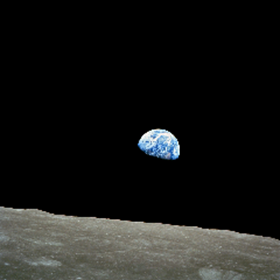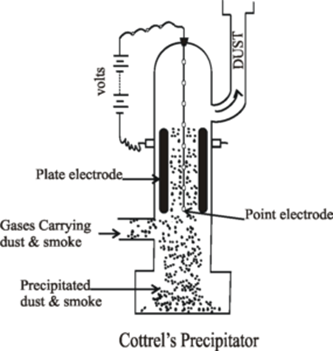Science > Chemistry > Colloids > Applications of Colloids
Natural Applications of Colloids:
Blue Colour of Sky:
When the light is incident on particles whose size is smaller than the wavelength of light, it is scattered. The blue colour of the sky is due to the scattering of light by small particles (dust particles along with water) of the atmosphere. According to Rayleigh the intensity of scattered light is inversely proportional to the fourth power of wavelength. As the wavelength of blue colour is smallest and that of red light is longest, the blue light is scattered most and the red light is scattered the least. The scattered blue light reaching the eye gives the appearance of a blue sky.

When the aeroplane is flying high where there are no dust particles or water vapour then no scattering of any colour takes place and the sky looks black.

Red and Orange Colour of Sky in The Sunrise and Sunset:
When the sun is low on the horizon, sunlight has to cover more distance through the atmosphere at sunset and sunrise than during the day, when the sun is higher in the sky. More distance through atmosphere means more molecules to scatter the violet and blue light away from our eyes. If the path is long enough, all of the blue and violet light scatters out of our line of sight. But the other colours continue on their way to our eyes. This is why sunrise and sunsets are often yellow, orange, and red.

Blue Colour of Sea:
The colloidal impurities in seawater due to their smaller size less than the wavelength of light scatter blue light. The Tyndall effect of scattering of light by colloids is responsible for the blue colour of the sea.

Fog Mist and Rain:
Fog, mist and rain are all colloidal in nature. In winters, at night, the moisture in the air condenses on the surface of dust particles, forming tiny droplets. These droplets, being colloidal in nature, float in the air and forms mist or fog.

Clouds are aerosols consisting of small droplets of water suspended in the air (aerosols). Clouds are the colloidal solution. On account of condensation in the upper atmosphere, the colloidal particles of water become bigger and bigger till they come down in the form of rain. They carry an electrical charge. The condensation occurs when the dust particles are cooled below its dew point. Sometimes rainfall occurs when oppositely charged clouds meet.
In the artificial rain, the clouds are sprayed by oppositely charged colloidal dust or sand particles or precipitates of silver iodide. This spraying neutralizes the charge on cloud resulting in coagulation of the water droplets which come down in the form of rain.

Industrial Applications of Colloids:
Thickening Agents:
Toothpaste, lotions, lubricants, coatings are the substances where the viscosity (degree of flow-ness) is very important. The substances added to them to change and maintain the viscosity are colloidal in nature. These colloid particles also provide stabilization of the colloidal solution and prevent the phase separation. They also act as fillers.
Example: various natural gums, microcrystalline cellulose, carboxymethyl cellulose, and fumed silica.
Paints:
Paints have been used since ancient times for both protective and decorative purposes. They consist basically of pigment particles dispersed in a liquid. The liquid capable of forming a stable solid film as the paint “dries”.on drying of the paint. On exposure to air, the pigments polymerize into the impervious film.
Inks:
The most critical properties of inks relate to their drying and surface properties. Inks must be able to flow properly and attach to the surface without penetrating it. It should dry very fast. Many inks consist of organic dyes dissolved in a water-based solvent and are not colloidal at all. The ink used in printing newspapers employs colloidal carbon black dispersed in an oil as the dispersion medium.
The inks employed in ball-point pens are gels, made in such a way that the ink will only flow over the ball and onto the paper when the shearing action of the ball (which rotates as it moves across the paper) “breaks” the gel into a liquid; the resulting liquid coats the ball and is transferred to the paper.
In conventional printing, the pigment particles remain on the paper surface, while the liquid gradually evaporates.
Rubber:
Latex obtained from rubber trees is an emulsion consisting of negatively charged rubber particles in water. Rubber is obtained by the coagulation of latex. This coagulated mass is later subjected to vulcanization and is solid as rubber with high abrasive strength. Vulcanized rubber is used in making tyres for vehicles.
Rubber plated articles can be prepared directly from latex by electrically depositing the negat6ively charged rubber particles over the article (made anode) which is to be rubber plated.
Leather Tanning Industry:
Raw skin hides of animals contain positively charged colloidal particles. These particles are coagulated by negatively charged tannin materials. After the tanning process, the leather becomes harder. Tanning material used are tannin and compounds of aluminium and chromium.
Cleansing Action of Soaps:
Soap solutions are colloidal in nature. They remove the dirt and oil particles either by adsorption or by emulsifying the greasy matter sticking to cloth.
Disinfectants:
Dettol and Lysol form an oil in water type colloidal solution which is used as the disinfecting agent.
Metallurgy:
The colloidal mixture of oil in water is used in the froth flotation process to separate sulphide ore particles.
Making of Photographic Plates:
Photographic plates and films are produced by coating an emulsion of the light-sensitive material like silver bromide in gelatin over class plates or celluloid films.
Sewage Precipitation:
Dirty and muddy water from gutters and drainages is called sewage is in colloidal form (colloidal solution).
Sewage water containing colloidal particles of mud, rubbish etc. is collected in a tank fitted with electrodes.
On applying an electric field, colloidal particles are attracted towards oppositely charged electrodes. As their charge gets neutralised, they settle as a precipitate. The precipitated or coagulated matter called sludge is used as manure while clear water is used for irrigation.
Smoke Precipitation:
Smoke is a colloidal solution of negatively charged carbon particles in the air (aerosol)
These carbon particles may condense water vapour on them and thus cities may have a thick cover of smog (smoke + fog). This smog causes air pollution.

Cottrel’s precipitator is a widely used smoke precipitator. Smoke is passed between metal electrodes at high voltage (about 50,000 V) The charged particles are neutralized at the oppositely charged electrode and get deposited there. The gases free from carbon particles are passed to a chimney or for further purification.
Other Applications of Colloids:
Synthetic plastics, rubber, graphite, lubricants, cement, etc. are colloidal solutions. Asphalt emulsion is used for road construction. The principles of colloids and interface science are used for the successful formulation and manufacture of photographic products.
Applications of Colloids in Food:
Food:
Most of the foods we eat are largely colloidal in nature. The function of food colloids generally has less to do with nutritional value than appearance, texture, and “mouthfeel”. Mouthfeel is the ability to “melt” (transform from gel to liquid emulsion) on contact with the warmth of the mouth.
Dairy Products:
milk (oil in water), butter (water in oil), halva, icecreams, are in colloidal form.
Fruit Juices:
Fruit juices are colloidal solutions
Eggs:
The clear, viscous “white” of the egg can be transformed into a white, opaque semi-solid by brief heating, or rendered into more intricate forms by poaching, frying, scrambling, or baking.
The raw egg white is a colloidal sol of long-chain protein molecules, all curled up into compact folded forms due to hydrogen bonding between different parts of the same molecule. On heating, the hydrogen bonds are broken, and proteins unfold. The opened chains tangle and bind with each other, transforming the sol into a cross-linked hydrogel, and changes its appearance to opaque white.
Applications of Colloids in Agriculture:
Soil:
The four major components of soils are mineral sediments, organic matter, water, and air. A fertile soil is colloidal in nature in which humus acts as a protective colloid.
Most soil colloids are negatively charged, and therefore attract cations such as Ca2+, Mg2+, and K+ into the outer parts of their double layers. As these ions are loosely bound, the plant roots can absorb these essential nutrients. Similarly, these ions are released into the soil again when the plant dies.
Formation of Delta:
River water is a colloidal solution of clay and seawater which mainly carry a negative charge. Seawater contains different electrolytes, mainly positive ions Na+, Mg2+, Ca2+. When the river meets the sea, the electrolytes in seawater bring about coagulation of clay particles in the river water. Thus the clay particles aggregate and settle down in course of water. Which results in the formation of a delta in due course.

Applications of Colloids in Medicine:
Colloidal medicines can act on a large surface area, hence they are more easily assimilated by the body. Therefore, they are more effective
Argyrol, a silver metal sol used as an eye lotion, colloidal antimony used for curing Kalaazar, colloidal gold used for inter-muscular injections.
Human Physiology:
Blood is a colloidal solution of albuminoid substances. Bleeding from a fresh cut can be stopped by applying a concentrated solution of ferric chloride or potash alum (this is known as the styptic action of alum or ferric chloride). In this case the cpagulation of blood takes place and a clot is formed which prevents further bleeding.
